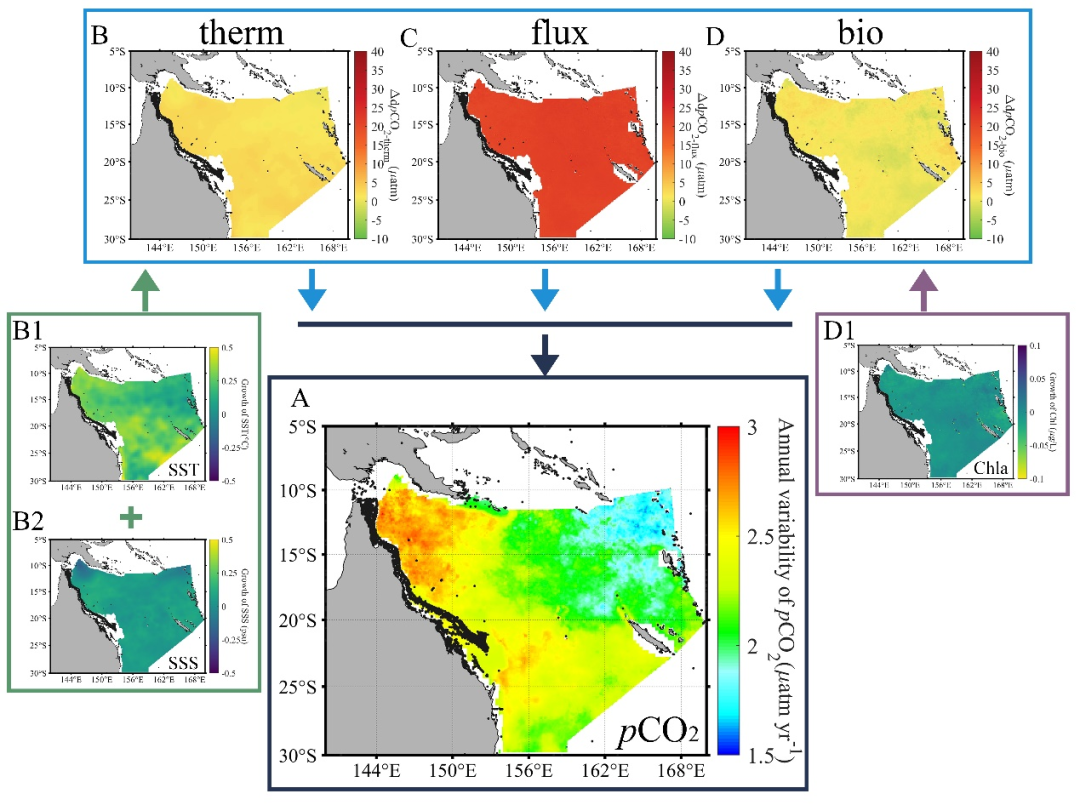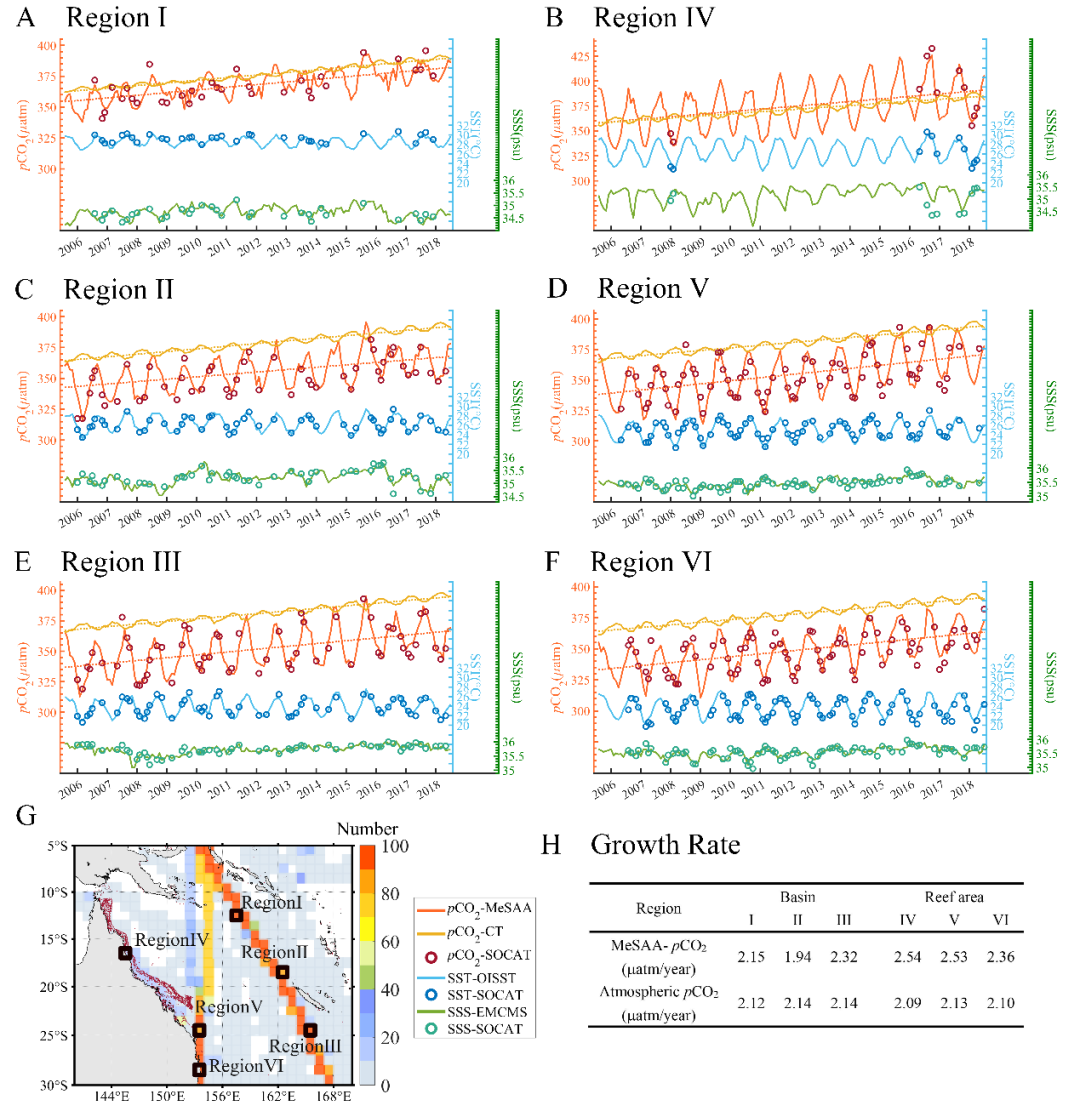Recently, our team of researchers from BAI Yan and their collaborators published a paper titled "The carbon sink of the Coral Sea, the world's second largest marginal sea," in the TOP journal Science of The Total Environment (IF=10.75) in environmental science and ecology. weakened during 2006–2018 (The carbon sink capacity of the Coral Sea, the world’s second largest marginal sea, is decreasing (2006-2018))” research paper. The first author of the paper is ZHANG Siqi, a doctoral student jointly trained by our laboratory and the University of Chinese Academy of Sciences. The corresponding author is researcher BAI Yan of our laboratory. The collaborators include researcher HE Xianqiang, senior engineer GONG Fang, senior engineer ZHU Qiankunzheng and researcher PAN Delu of our laboratory.
The Global Carbon Plan GCP 2022 report shows that the ocean has absorbed about 26% of anthropogenic CO2. Against the background of increasing atmospheric CO2 concentration, the carbon sink capacity of the global ocean is also increasing, but different marginal sea systems have different carbon sink change characteristics. difference. Using remote sensing methods to understand the carbon source and sink patterns and changes in different marginal sea systems around the world will help us deeply understand the changes in ocean carbon sequestration capacity under the multiple pressures of global climate change and human activities.
The Coral Sea is the second largest marginal sea in the world, including a vast oligotrophic sea basin and the Great Barrier Reef, a biodiversity hotspot. The biogeochemical processes of seawater are complex. Subject to uneven spatial and temporal distribution of observation samples, the Coral Sea’s sea-air CO2 flux There has been a lack of sufficient research on changes in the amount and carbon sink capacity of seawater. This study is based on the semi-analytical inversion algorithm (MeSAA) of seawater CO2 partial pressure based on the control mechanism built by the team earlier (Bai*, et al., 2015). According to the regional ocean characteristics of the Coral Sea, the growth of atmospheric CO2 concentration is increased. To quantify the impact, the Coral Sea high spatial resolution pCO2 and sea-to-air CO2 flux remote sensing data sets from 2006 to 2018 were reconstructed (Fig. 1). Verified by a large number of independent measured data, this data set has high accuracy in the ocean basin (RMSE<10μatm, R2>0.72) and coral reef area (RMSE<12μatm, R2>0.8), and can well restore the pCO2 of Coral Sea water. Long time series changes (Figure 2).

Figure 1 Spatial distribution map of monthly average seawater pCO2 in the Coral Sea climate state from 2006 to 2018.
Figure 2 (A-F) Time series plots of monthly changes in pCO2, temperature and salinity in six 1º × 1º sub-regions from 2006 to 2018. The open circles represent the measured monthly average data from the SOCAT dataset, and the solid lines are the model or satellite remote sensing monthly average data under simultaneous and spatial matching. (G) Schematic diagram of the locations of the six sub-regions. (H) The average annual growth rate of satellite-retrieved MeSAA-pCO2 and atmospheric pCO2 from CarbonTracker in the sub-region (both P values are less than 0.001).
We found that under the forcing of increased atmospheric CO2, Coral Sea seawater pCO2 also continued to increase (the growth rate was 1.8~2.7 μatm/year), and the growth rate was higher than that of the atmosphere. Affected by factors such as coastal transport of high pCO2 seawater from nearshore coral reefs and water mass retention, nearshore seawater pCO2 increases faster (>2.5 μatm/year). From 2006 to 2018, the Coral Sea was a carbon sink as a whole, but the absorption of atmospheric CO2 by seawater showed a decreasing trend (the sea-to-air CO2 flux in 2016 was only 52% of that in 2006). Factors such as rising seawater pCO2, high pCO2 seawater affected by coral reefs near the coast, and low productivity of oligotrophic sea basins have led to the gradual weakening of the Coral Sea carbon sink. This carbon sink weakening phenomenon is more obvious after strong El Niño events (such as 2007, 2010, and 2016). The corresponding high SST and low wind speed further reduce the sea-air CO2 flux and weaken the carbon sink.
Different from other traditional pCO2 regional algorithms based on large data matching of environmental parameters and target parameters (such as multiple regression methods or machine learning algorithms, etc.), the MeSAA algorithm we built in the Coral Sea only uses 14.2% of the data for the algorithm. Construction (single factor master control and small area data with less interference from other mechanisms), leaving 85.8% of completely independent data for verification. The MeSAA-pCO2 algorithm not only provides more independent data for verification, but also helps us analyze and understand the impact of different processes on pCO2 changes because its modeling process quantifies the control mechanism of seawater pCO2. We used the difference between February and August to characterize intra-annual variation and found that thermodynamic effects on temperature affected pCO2 at ~5-45 µatm and biological effects at ~5-20 µatm. In terms of trend changes, thermodynamic, biological and other factors (mainly The relative contribution of atmospheric CO2 rise) in interannual changes was found to be approximately 27:3:1 in the Coral Sea seawater pCO2 from 2006 to 2018 due to atmospheric forcing: thermodynamic effects: biological effects (Figure 3). Although temperature controls seasonal changes in sea surface pCO2, the annual increase in atmospheric CO2 is one of the key reasons for the rise in Coral Sea water pCO2 from 2006 to 2018. These understandings of long-term sequence changes in the Coral Sea can provide new perspectives on changes in marginal sea carbonate systems and the evolution of seawater carbon sink capabilities.

Figure 3. (A) Spatial distribution of pCO2 growth rate from 2006 to 2018 (unit: μatm/year), as well as P06-10 (climate state seawater pCO2 from 2006 to 2010) and P14-18 (climate state seawater from 2014 to 2018 Changes in seawater pCO2 caused by thermodynamic effects (B), atmospheric forcing (C) and biological effects (D). Increments in temperature (B1), salinity (B2) and Chla (D1) in the Coral Sea between 2006-2010 and 2014-2018. *Note: In the growth rate calculation, the P values are all less than 0.001.
Citation: Zhang, S., Bai, Y.*, He, X., Yu, S., Song, Z., Gong, F., Zhu, Q., & Pan, D. (2023). The carbon sink of the Coral Sea, the world's second largest marginal sea, weakened during 2006–2018 Science of The Total Environment , 872.


